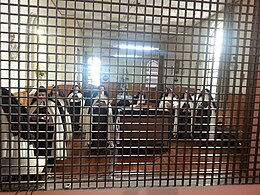


Enclosed religious orders are religious orders whose members strictly separate themselves from the affairs of the external world. The term cloistered is synonymous with enclosed. In the Catholic Church, enclosure is regulated by the code of canon law, either the Latin code or the Oriental code, and also by the constitutions of the specific order.[1][2][3] It is practised with a variety of customs according to the nature and charism of the community in question. This separation may involve physical barriers such as walls and grilles (that is, a literal cloister), with entry restricted for other people and certain areas exclusively permitted to the members of the convent. Outsiders may only temporarily enter this area under certain conditions (for example, if they are candidates for the order, doctors or craftsmen). The intended purpose for such enclosure is to prevent distraction from prayer and the religious life and to keep an atmosphere of silence.
Under certain circumstances, exceptions may be granted for enclosed men or women to leave the enclosure temporarily or permanently.
Enclosed religious orders of men include monks following the Rule of Saint Benedict, namely the Benedictine, the Cistercian, and the Trappist orders, but also monks of the Carthusians, Hieronymites, along with the male and female members of the Monastic Family of Bethlehem, of the Assumption of the Virgin and of Saint Bruno, while enclosed religious orders of women include Canonesses Regular, nuns belonging to the Benedictine, Cistercian, Trappist and the Carthusian orders, along with the nuns of the second order of each of the mendicant orders, including: the nuns of the Poor Clares, the Colettine Poor Clares, the Capuchin Poor Clares, the Dominicans, Carmelites and Discalced Carmelites, Servites, Augustinians, Minims, together with the Conceptionists, the Visitandines and the Ursulines.
- ^ VATICAN: Verbi Sponsa - Instruction on the Contemplative Life and on the Enclosure of Nuns
- ^ The Code of Canon Law, Canon 667 ff. English translation copyright 1983 The Canon Law Society Trust "Code of Canon Law Index". Archived from the original on 19 June 2006. Retrieved 17 June 2006.
- ^ Codex Iuris Canonici Can. 637, § 4